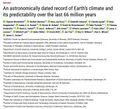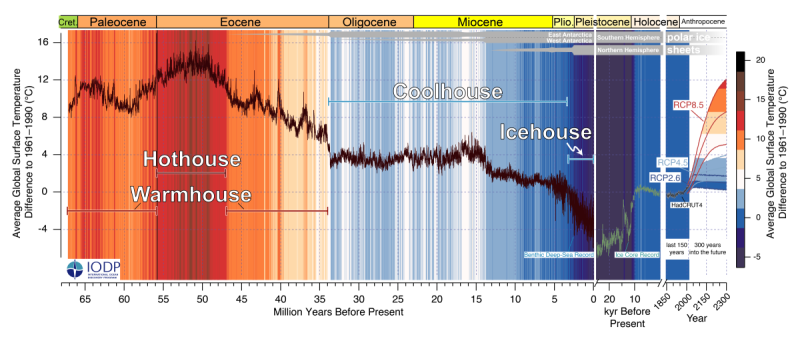File:Dated record of Earths climate - Science Report Sept 10 2020.jpg: Difference between revisions
Siterunner (talk | contribs) No edit summary |
Siterunner (talk | contribs) No edit summary |
||
| Line 3: | Line 3: | ||
[[File:Toward the Hothouse.png]] | [[File:Toward the Hothouse.png]] | ||
[https://www.eurekalert.org/multimedia/pub/242377.php <small>''Past and Future Trends (Image)''</small>] | |||
: <small>''Past and future trends in global mean temperature spanning the last 67 million years''</small> | |||
<big><big>'''Earth barreling toward 'Hothouse' state not seen in 50 million years'''</big></big> | |||
* https://www.eurekalert.org/pub_releases/2020-09/uoc--hro090820.php | |||
* https://www.livescience.com/amp/oldest-climate-record-ever-cenozoic-era.html | |||
* https://science.sciencemag.org/content/369/6509/1383 | |||
* https://phys.org/news/2020-09-high-fidelity-earth-climate-history-current.html | |||
''For the first time, climate scientists have compiled a continuous, high-fidelity record of variations in Earth's climate extending 66 million years into the past. The record reveals four distinctive climate states, which the researchers dubbed Hothouse, Warmhouse, Coolhouse, and Icehouse.'' | |||
''These major climate states persisted for millions and sometimes tens of millions of years, and within each one the climate shows rhythmic variations corresponding to changes in Earth's orbit around the sun. But each climate state has a distinctive response to orbital variations, which drive relatively small changes in global temperatures compared with the dramatic shifts between different climate states.'' | |||
''The new findings, '''published September 10 in Science''', are the result of decades of work and a large international collaboration. The challenge was to determine past climate variations on a time scale fine enough to see the variability attributable to orbital variations (in the eccentricity of Earth's orbit around the sun and the precession and tilt of its rotational axis).'' | |||
''"We've known for a long time that the glacial-interglacial cycles are paced by changes in Earth's orbit, which alter the amount of solar energy reaching Earth's surface, and astronomers have been computing these orbital variations back in time," explained coauthor James Zachos, distinguished professor of Earth and planetary sciences and Ida Benson Lynn Professor of Ocean Health at UC Santa Cruz.'' | |||
''"As we reconstructed past climates, we could see long-term coarse changes quite well. We also knew there should be finer-scale rhythmic variability due to orbital variations, but for a long time it was considered impossible to recover that signal," Zachos said. "Now that we have succeeded in capturing the natural climate variability, we can see that the projected anthropogenic warming will be much greater than that."'' | |||
○ | |||
[[Category:Climate Change]] | |||
[[Category:Climate Policy]] | |||
[[Category:About Us]] | |||
[[Category:Air Quality]] | |||
[[Category:Air Pollution]] | |||
[[Category:Agriculture]] | |||
[[Category:Alternative Agriculture]] | |||
[[Category:Antarctica]] | |||
[[Category:Anthropocene]] | |||
[[Category:Arctic]] | |||
[[Category:Atmospheric Science]] | |||
[[Category:Citizen Science]] | |||
[[Category:City Governments]] | |||
[[Category:Climate Migration]] | |||
[[Category:County Governments]] | |||
[[Category:Desertification]] | |||
[[Category:Digital Citizen]] | |||
[[Category:Earth Imaging]] | |||
[[Category:Earth Observations]] | |||
[[Category:Earth360]] | |||
[[Category:Earth Science]] | |||
[[Category:Earth Science from Space]] | |||
[[Category:Earth System Science]] | |||
[[Category:Ecology Studies]] | |||
[[Category:Eco-nomics]] | |||
[[Category:Economic Justice]] | |||
[[Category:Education]] | |||
[[Category:Energy]] | |||
[[Category:Environmental Laws]] | |||
[[Category:Environmental Protection]] | |||
[[Category:Environmental Security]] | |||
[[Category:Environmental Security, National Security]] | |||
[[Category:ESA]] | |||
[[Category:European Union]] | |||
[[Category:Externalities]] | |||
[[Category:Extinction]] | |||
[[Category:Florida]] | |||
[[Category:Food]] | |||
[[Category:Forests]] | |||
[[Category:Fossil Fuels]] | |||
[[Category:Greenland]] | |||
[[Category:Global Security]] | |||
[[Category:Global Warming]] | |||
[[Category:Green Graphics]] | |||
[[Category:Green Networking]] | |||
[[Category:Green Best Practices]] | |||
[[Category:Green Politics]] | |||
[[Category:Health]] | |||
[[Category:INDC]] | |||
[[Category:Maps]] | |||
[[Category:Money in Politics]] | |||
[[Category:NASA]] | |||
[[Category:NOAA]] | |||
[[Category:Natural Resources]] | |||
[[Category:Networking]] | |||
[[Category:New Definitions of National Security]] | |||
[[Category:New Economy]] | |||
[[Category:New Space]] | |||
[[Category:Oceans]] | |||
[[Category:Ocean Science]] | |||
[[Category:Online Education]] | |||
[[Category:Planet Citizen]] | |||
[[Category:Planet Citizens]] | |||
[[Category:Planet Citizens, Planet Scientists]] | |||
[[Category:Rainforest]] | |||
[[Category:Renewable Energy]] | |||
[[Category:Resilience]] | |||
[[Category:Sea-level Rise]] | |||
[[Category:Sea-Level Rise & Mitigation]] | |||
[[Category:Social Justice]] | |||
[[Category:Soil]] | |||
[[Category:Solar Energy]] | |||
[[Category:Strategic Demands]] | |||
[[Category:Sustainability Policies]] | |||
[[Category:Threat Multiplier]] | |||
[[Category:United Nations]] | |||
[[Category:US]] | |||
[[Category:US Environmental Protection Agency]] | |||
[[Category:Water Quality]] | |||
[[Category:Whole Earth]] | |||
[[Category:Wind Energy]] | |||
Latest revision as of 14:32, 11 September 2020
Past and Future Trends (Image)
- Past and future trends in global mean temperature spanning the last 67 million years
Earth barreling toward 'Hothouse' state not seen in 50 million years
For the first time, climate scientists have compiled a continuous, high-fidelity record of variations in Earth's climate extending 66 million years into the past. The record reveals four distinctive climate states, which the researchers dubbed Hothouse, Warmhouse, Coolhouse, and Icehouse.
These major climate states persisted for millions and sometimes tens of millions of years, and within each one the climate shows rhythmic variations corresponding to changes in Earth's orbit around the sun. But each climate state has a distinctive response to orbital variations, which drive relatively small changes in global temperatures compared with the dramatic shifts between different climate states.
The new findings, published September 10 in Science, are the result of decades of work and a large international collaboration. The challenge was to determine past climate variations on a time scale fine enough to see the variability attributable to orbital variations (in the eccentricity of Earth's orbit around the sun and the precession and tilt of its rotational axis).
"We've known for a long time that the glacial-interglacial cycles are paced by changes in Earth's orbit, which alter the amount of solar energy reaching Earth's surface, and astronomers have been computing these orbital variations back in time," explained coauthor James Zachos, distinguished professor of Earth and planetary sciences and Ida Benson Lynn Professor of Ocean Health at UC Santa Cruz.
"As we reconstructed past climates, we could see long-term coarse changes quite well. We also knew there should be finer-scale rhythmic variability due to orbital variations, but for a long time it was considered impossible to recover that signal," Zachos said. "Now that we have succeeded in capturing the natural climate variability, we can see that the projected anthropogenic warming will be much greater than that."
○
File history
Click on a date/time to view the file as it appeared at that time.
| Date/Time | Thumbnail | Dimensions | User | Comment | |
|---|---|---|---|---|---|
| current | 14:31, 11 September 2020 |  | 735 × 669 (192 KB) | Siterunner (talk | contribs) |
You cannot overwrite this file.
File usage
The following page uses this file:
- Climate Change
- Climate Policy
- About Us
- Air Quality
- Air Pollution
- Agriculture
- Alternative Agriculture
- Antarctica
- Anthropocene
- Arctic
- Atmospheric Science
- Citizen Science
- City Governments
- Climate Migration
- County Governments
- Desertification
- Digital Citizen
- Earth Imaging
- Earth Observations
- Earth360
- Earth Science
- Earth Science from Space
- Earth System Science
- Ecology Studies
- Eco-nomics
- Economic Justice
- Education
- Energy
- Environmental Laws
- Environmental Protection
- Environmental Security
- Environmental Security, National Security
- ESA
- European Union
- Externalities
- Extinction
- Florida
- Food
- Forests
- Fossil Fuels
- Greenland
- Global Security
- Global Warming
- Green Graphics
- Green Networking
- Green Best Practices
- Green Politics
- Health
- INDC
- Maps
- Money in Politics
- NASA
- NOAA
- Natural Resources
- Networking
- New Definitions of National Security
- New Economy
- New Space
- Oceans
- Ocean Science
- Online Education
- Planet Citizen
- Planet Citizens
- Planet Citizens, Planet Scientists
- Rainforest
- Renewable Energy
- Resilience
- Sea-level Rise
- Sea-Level Rise & Mitigation
- Social Justice
- Soil
- Solar Energy
- Strategic Demands
- Sustainability Policies
- Threat Multiplier
- United Nations
- US
- US Environmental Protection Agency
- Water Quality
- Whole Earth
- Wind Energy
